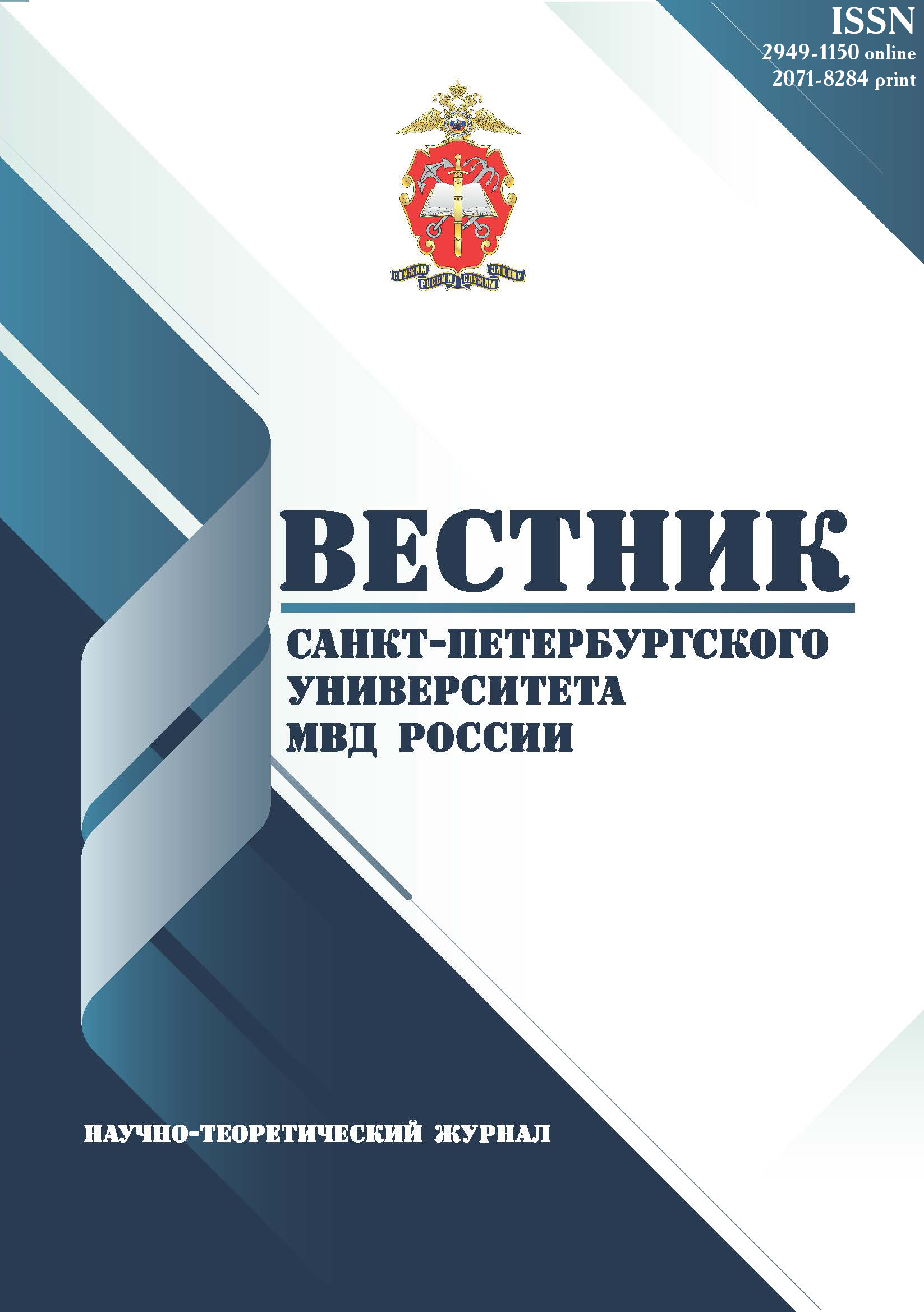UDC 343.92
Introduction. The study is devoted to the description of the possibilities of the subjective approach to identifying the criminogenicity of the individual on the example of his/her relations to the social environment. It notes the disparate perceptions of criminogenicity, which requires the integration of scientific knowledge. The author suggests the possibilities of the subjective approach to describe the criminogenicity of personality. The specificity of the description of criminogenicity in individual-psychological and socioenvironmental concepts is determined. The current state of genetic and neuropsychological studies of personality criminogenicity is described. The role of socio-environmental concepts is revealed. The importance of society in the formation of criminogenicity is noted in the concepts of anomie, social control and socialisation of personality. The importance of subjective attitude mediating the influence of individualpsychological and social-mediological factors is emphasised. Methods. The methodology of the subject approach was applied in the research process, general scientific (induction, analysis, synthesis) and private-scientific (extrapolation) research methods were used. Results. The possibilities of the subjective approach to the analysis of the causes of criminogenicity of personality, which are not explained by individual-psychological and socio-environmental concepts of criminogenicity, are described. It is determined that criminogenicity can be considered as a socially negative form of self-actualisation of personality. The self-actualisationis explained through the purposeful manifestation of cognitive and regulatory abilities in order to achieve a personally significant goal. At the same time subjectivity is characterised by defects of moral and ethical sphere, allowing preferring criminal behaviour to law-abiding in the situation of choice. It is noted that the manifestation of subjectivity can be characterised in the context of relations to the social environment, acting as a means of achieving selfrealisation. The results extend and clarify the possibilities of the subjective approach as applied to the analysis of criminogenic personality. The peculiarities of the implementation of subjectivity of a criminogenic personality in terms of overcoming the difficulties of life activity, formation of self-relationship and involvement of others in self-realisation are shown. The prospects of studying the causes, state and characteristics of relations of criminogenic personality to social environment as a source of new information about criminalisation and decriminalisation of personality are outlined.
subject approach, criminogenic personality, biological causes of crime, criminalisation, resocialisation of convicts, crime psychology
1. Abaturov A. I. Postpenitenciarnoe soprovozhdenie osuzhdennyh: problemy i real'nost' // Vestnik Tomskogo instituta povysheniya kvalifikacii rabotnikov FSIN Rossii. - 2023. - № 1 (15). - S. 8-14.
2. Antonyan Yu. M. Lichnost' prestupnika i ispravlenie osuzhdennyh // Vestnik RGGU. Seriya «Ekonomika. Upravlenie. Pravo». - 2019. - № 2. - S. 117-127.
3. Antonyan Yu. M. Rol' konkretnoy zhiznennoy situacii v sovershenii prestupleniya. - Moskva: Akademiya MVD SSSR, 1973. - 70 s.
4. Ancyferova L. I. Psihologiya formirovaniya i razvitiya lichnosti // Chelovek v sisteme nauk. - Moskva: Nauka, 1989. - S. 426-433.
5. Brailovskiy V. V. Opyt bio-social'nogo issledovaniya ubiyc: (po materialam mest zaklyucheniya Severnogo Kavkaza). - Rostov-na-Donu: Tipografiya izdatel'stva «Donskaya pravda», 1929. - 178 s.
6. Burlakov V. N. Kriminogennaya lichnost' i individual'noe preduprezhdenie prestupleniy: problemy modelirovaniya. - Sankt-Peterburg: Sankt-Peterburgskaya akademiya MVD Rossii, 1998. - 235 s.
7. Galkina G. D., Chupina V. A. Izmenenie cennostno-smyslovoy sfery lichnosti osuzhdennyh kak neobhodimoe uslovie formirovaniya pravoposlushnogo povedeniya / Akmeologiya professional'nogo obrazovaniya; O. B. Akimova, N. K. Chapaev, N. V. Lomovceva (red.). - Ekaterinburg: Rossiyskiy gosudarstvennyy professional'no-pedagogicheskiy universitet, 2020. - S. 285-291.
8. Zlokazov K. V. Social'noe prostranstvo v predstavlenii prestupnika : monografiya. - Sankt-Peterburg: Sankt-Peterburgskiy universitet MVD Rossii, 2021 - 264 s.
9. Korzun D. N., Tkachenko A. A. Problemy ekspertnoy differenciacii yuridicheski znachimyh sposobnostey lic s psihicheskimi rasstroystvami // Psihicheskoe zdorov'e. - 2012. - № 11. - S. 36-41.
10. Ol'hovik N. V., Prozumentov L. M. Recidivnaya prestupnost' osuzhdennyh i ee preduprezhdenie. - Tomsk: Izdatel'stvo Tomskogo universiteta, 2009 - 159 s.
11. Poznyshev S. V. Kriminal'naya psihologiya. Prestupnye tipy. - Leningrad: Gosizdat, 1926. - 255 s.
12. Pryadein V. P., Smirnov A. V., Chernysheva E. V. Motivaciya pravonarusheniy u social'no normativnyh lic. - Ekaterinburg: Ural'skiy gosudarstvennyy pedagogicheskiy universitet, 2023. - 252 s.
13. Rubinshteyn S. L. Bytie i soznanie. Chelovek i mir. - Sankt-Peterburg: Piter, 2003. - 508 s.
14. Berryessa C. M. Potential implications of research on genetic or heritable contributions to pedophilia for the objectives of criminal law. Recent Adv DNA Gene Seq. - Vol. 8. - 2014.- P. 65-77.
15. Demers C. H., Bogdan R., Agrawal A. The Genetics, Neurogenetics and Pharmacogenetics of Addiction. Curr Behav Neurosci Rep. - Vol. 1. - 2014. - P. 33-44.
16. Dorfman H. M., Meyer-Lindenberg, A., & Buckholtz J. W. Neurobiological mechanisms for impulsiveaggression: the role of MAOA. Current topics in behavioral neurosciences. - Vol. 17. - 2014. - P. 297-313.
17. Duster T. Behavioral genetics and explanations of the link between crime, violence, and race. In: Parens E, Chapman AR, Press N, editors. Wrestling with Behavioral Genetics: Science, Ethics, and Public Conversation. - Baltimore, MD: John Hopkins University Press, 2006. - P. 150-175.
18. Hancock M., Tapscott J. L., Hoaken P. N. Role of executive dysfunction in predicting frequency and severity of violence. Aggressive Behavior. - Vol. 36 (5). - 2010. - P. 338-349.
19. Matsueda R. L. Differential social organization, collective action, and crime. Crime, Law and Social Change. - Vol. 46 (1-2). - 2006. - P. 3-33. - https://doi.org/10.1007/s10611-006-9045-1.
20. Mazurek, C., Brook, M., Kwasny, M., & Hanlon, R. E. Homicidal Physical Violence: An Exploratory Analysis of Relevant Cognitive, Demographic, and Criminological Factors in a Sample of Murderers. Homicide Studies. - Vol. 25(1). - 2021. - P. 61-82. - https://doi.org/10.1177/1088767920935161.
21. McSwiggan, S., Elger, B., & Appelbaum, P. S. The forensic use of behavioral genetics in criminal proceedings: Case of the MAOA-L genotype. International Journal of Law and Psychiatry. - Vol. 50. - 2017. - P. 17-23. - https://doi.org/10.1016/j.ijlp.2016.09.005.
22. Peng J., Zhang J., Yuan W., Zhou X., Tian J., & Fang P. The commission of crime from the perspective of decision-making differences. Frontiers in Psychology. - Vol.13. - 2022. - https://doi.org/10.3389/fpsyg.2022.937876.
23. Simons R. L., & Burt C. H. Learning to be bad: adverse social conditions, social schemas, and crime. Criminology. - Vol. 49 (2). - 2011. - P. 553-598. Portico. - https://doi.org/10.1111/j.1745-9125.2011.00231.x
24. Van Gelder, J.-L., and De Vries, R. E. Rational misbehavior? evaluating an integrated dual-process model of criminal decision making. J. Quan. Criminol. - Vol. 30. - 2014. - P. 1-27.
25. Venturi da Silva L., & Cavalheiro H. A. Neuropsychological Assessment in The Forensic Context: A Scoping Review. Brazilian Journal of Forensic Sciences, Medical Law and Bioethics. - Vol. 12 (1). - 2022. - P. 53-74. - https://doi.org/10.17063/bjfs12(1)y202253-74.
















